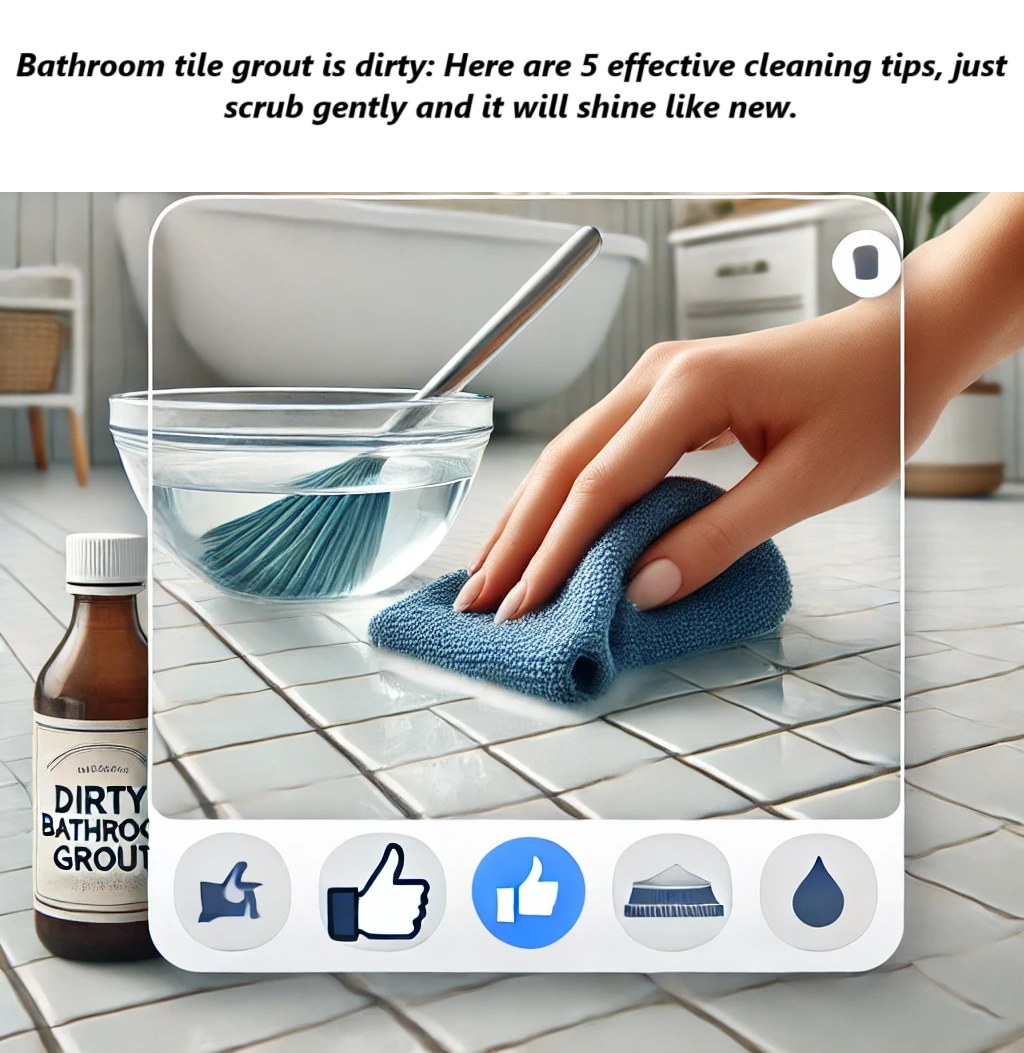ADVERTISEMENT
#### Why It Works:
The **baking soda** acts as a mild abrasive to scrub away dirt, while **vinegar** helps to break down soap scum and mineral deposits. Together, they make a powerful yet gentle cleaner for grout.
### 2. **Hydrogen Peroxide for Stubborn Stains**
If your grout has some tough stains that baking soda and vinegar can’t tackle, **hydrogen peroxide** is an excellent option. It’s a natural bleach that can help lift stubborn stains and disinfect the grout lines.
#### How to Use:
– Apply **3% hydrogen peroxide** directly onto the grout lines. You can use a spray bottle or a sponge for more control.
– Let it sit for **5-10 minutes**. The hydrogen peroxide will break down the dirt and mildew.
– Gently scrub with a **toothbrush** to lift the stains.
– Rinse with warm water and wipe dry.
#### Why It Works:
Hydrogen peroxide is a powerful cleaning agent that helps to lighten stains and disinfect the area. It’s ideal for bathroom grout, as it effectively fights mold and mildew, which thrive in damp environments.
### 3. **Steam Cleaning for a Deep Clean**
For a chemical-free solution that’s tough on grime yet gentle on grout, consider **steam cleaning**. A steam cleaner can blast away dirt and bacteria from your grout lines using only hot water and steam, making it a great option for sensitive surfaces.
#### How to Use:
– Fill the **steam cleaner** with water and heat it up according to the manufacturer’s instructions.
– Use the **grout attachment** (or a nozzle with a small, concentrated steam head) to target the grout lines.
– Slowly move the steam nozzle across the grout, allowing the hot steam to penetrate the pores of the grout and lift dirt.
– After steaming, use a **soft towel** to wipe away the loosened grime.
#### Why It Works:
Steam cleaning uses high heat and pressure to break down dirt and grime without the need for chemicals, making it both effective and environmentally friendly. It also helps kill bacteria and mold, which can be common in bathrooms.
### 4. **Oxygen Bleach for Heavy Duty Cleaning**
If you’re dealing with extremely dirty grout or grout that has developed mold or mildew, **oxygen bleach** is a fantastic solution. Unlike traditional chlorine bleach, oxygen bleach is non-toxic and safe for most surfaces, including grout.
#### How to Use:
– Mix **oxygen bleach powder** with warm water according to the instructions on the product packaging. You can use a bucket or large container to mix the solution.
– Apply the solution directly onto the grout lines using a sponge or mop.
– Let the solution sit for about **15-20 minutes** to penetrate the grime and stains.
– Scrub gently with a **toothbrush** or grout brush.
– Rinse thoroughly with clean water and dry with a towel.
#### Why It Works:
Oxygen bleach releases oxygen as it breaks down dirt and stains, which helps to lift grime from the porous grout surface. It’s particularly effective for grout that has been heavily stained or discolored over time.
### 5. **Grout Cleaning Pen for Quick Touch-Ups**
For smaller areas or grout lines that just need a quick touch-up, a **grout cleaning pen** is a handy tool. These pens contain a cleaning solution that’s easy to apply directly to the grout lines, helping to brighten them instantly.
#### How to Use:
– Shake the grout cleaning pen to activate the solution.
– Apply the solution directly to the grout lines, focusing on any areas that look dirty or stained.
– Use a **small brush** or the pen’s built-in applicator to scrub the grout gently.
– Wipe away any excess solution with a damp cloth.
#### Why It Works:
Grout cleaning pens are a convenient option for spot cleaning or for maintaining grout in areas that don’t need a deep clean. They are perfect for quick touch-ups and can help maintain grout’s appearance over time.
—
### Tips for Keeping Grout Clean Longer
After cleaning your grout and getting it back to its pristine state, you’ll want to keep it that way! Here are some tips for maintaining clean grout lines in the future:
1. **Seal Your Grout**: After cleaning, apply a grout sealer to protect it from stains and moisture. This will make it easier to clean in the future and keep grime from penetrating the porous grout.
2. **Wipe Down Tiles After Showers**: To prevent soap scum and moisture buildup, wipe down your tiles and grout lines after each shower or bath. A squeegee or microfiber cloth works well for this.
3. **Use a Daily Shower Cleaner**: Consider using a daily shower spray that helps prevent the buildup of mold, mildew, and soap scum, making your cleaning routine even easier.
4. **Ventilate Your Bathroom**: High humidity is one of the main causes of mold and mildew in grout. Keep your bathroom well-ventilated by using an exhaust fan or opening a window after showers to reduce moisture levels.
—
### Conclusion
With the right tools and techniques, cleaning dirty bathroom tile grout doesn’t have to be a hassle. Whether you use the classic baking soda and vinegar method, try steam cleaning, or opt for a grout cleaning pen, these **5 effective cleaning tips** will help restore your grout lines and keep your bathroom looking fresh and spotless.
By taking a little time to clean and maintain your grout, you can enjoy a bathroom that feels like new again, with sparkling tile and pristine grout lines that shine with every use. So, grab your cleaning supplies and get ready to scrub gently—your grout will thank you!
ADVERTISEMENT
